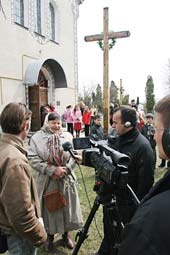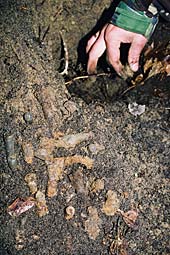The Holocaust by bullets, shooting in Ukraine - Shoah Memorial
- Presentation of the exhibition
- The Jews in Ukraine
- The beginning of the genocidal policy
- The radicalization of genocide
- Father Patrick Desbois and Yahad-In Unum
- The stages of execution
- Panoramic views of the exhibition
Father Patrick Desbois and Yahad-In Unum
Father Patrick Desbois
Father Patrick Desbois, whose grandfather had been deported to Stalag 325 in Rava Ruska, has undertaken for six years a methodical and long-term work on the history of the extermination of one and a half million Jews from Ukraine: identify and examine all the sites of exterminations of Jews perpetrated by Nazi mobile units in Ukraine during the Second World War with the ultimate goal of offering a decent burial to these Jews shot in Ukraine.
This work, undertaken with the association Yahad-In Unum, created in January 2004 at the initiative of Cardinal Jean-Marie Lustiger and Cardinal Jean-Pierre Ricard on one hand, and Mr. Israël Singer on the other hand, and whose father Patrick Desbois, director of the Episcopal Service for relations with Judaism, is the president, receives support from the Foundation for the Memory of the Shoah and from Pope Benoit XVI in a letter dated 12 November 2005 addressed to Cardinal Lustiger.
This research, which until today has covered about a third of the territory concerned, has allowed to lift the veil on the exact conditions of this mass murder.
The research of Yahad-In Unum in Ukraine
Yahad-In Unum’s research in Ukraine takes place in three stages: information searches in the German and Soviet archives, field research (recording of testimonies, location of places, ballistic investigations) and collects material evidence of the genocide.
Archival research:
The archives of the German courts and the Soviet commissions make it possible to acquire initial information concerning the massacres committed by the Nazis in the Soviet Union, particularly in Ukraine between 1941 and 1944. These various funds inform the researchers of Yahad on the missions given to the German troops regarding the fate of the Jews, on the location of certain places of massacres, and give a starting point for work in the field.
Visit of the sites and recording of testimonies:
Father Desbois and a team of experts regularly travel the regions of Ukraine in order to identify the witnesses of the genocide still alive today. At the time of the facts, these witnesses were curious children or teenagers, who either followed the columns of Jews going to the places of execution or who, hidden, observed the executions, or were among those who, requisitioned by the Germans with the complicity of the local authorities, participated in the digging or filling of the pits, in the transport of victims or equipment. All often testify for the first time after sixty years of silence.
It is based on three corroborating testimonies collected independently that Yahad-In Unum admits the location of an unknown execution site until now.
Identification of Jewish mass graves and collection of ballistic evidence:
On the indications of the witnesses, the location of the pit is identified. The German casings, which are all dated, or any other ballistic evidence is collected before the location of the pit is camouflaged, in order to prevent the grave robbers from desecrating it.
The presence of German shells around mass graves is important evidence that the execution was carried out by Nazi mobile units. Alongside this evidence, the team collected some personal items belonging to the victims: glasses, children’s games, jewelry, which were able to escape the covetousness of the killers. Five hundred execution sites have already been identified.
The exhibition organized at the Shoah Memorial presents the first results of this research, some of the ballistic evidence found on the sites and a selection of testimonies collected over the past six years by the Yahad-In Unum team.
The exhibition also traces the archaeological expertise of a mass grave, conducted in the village of Busk at the request of the Shoah Memorial by the team of Father Patrick Desbois in August 2006 and whose results confirm the terrible reality of the genocide by bullets carried out between 1941 and 1944 in Ukraine and throughout Soviet territory by troops Nazies.

An interview conducted at the end of the mass.
© Guillaume Ribot

Two witnesses mark the location of a pit with gestures.
© Guillaume Ribot

The presence of shells confirms the location of the pits.
© Guillaume Ribot

View of the site of Busk, in the region of Lvov where 15 mass graves were located in an old Jewish cemetery.
© Guillaume Ribot